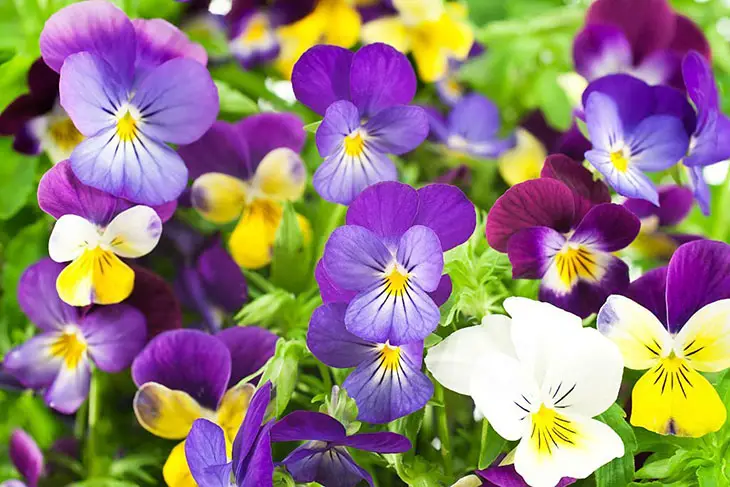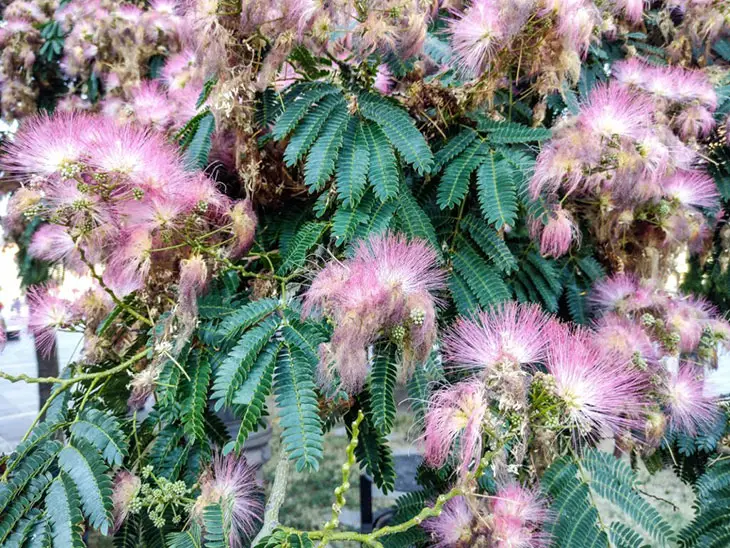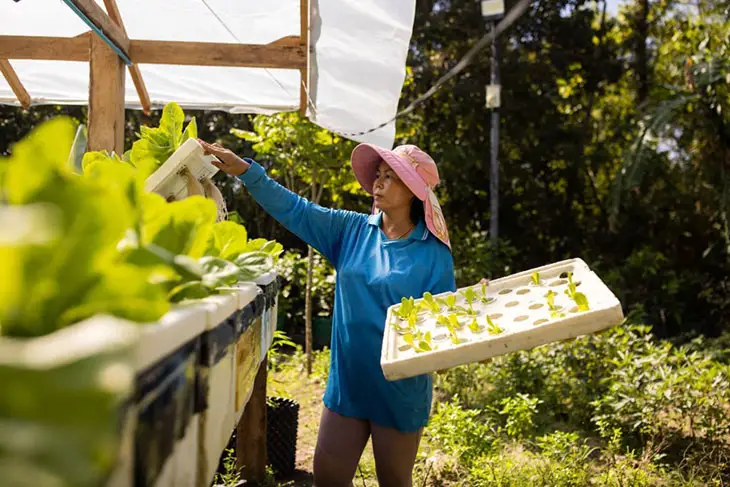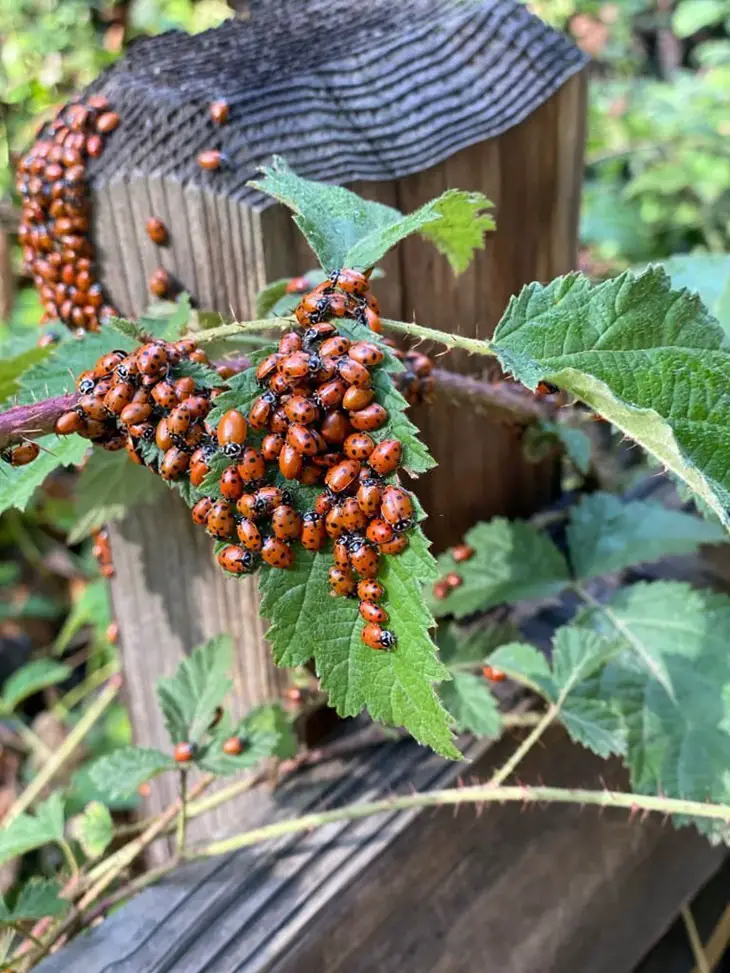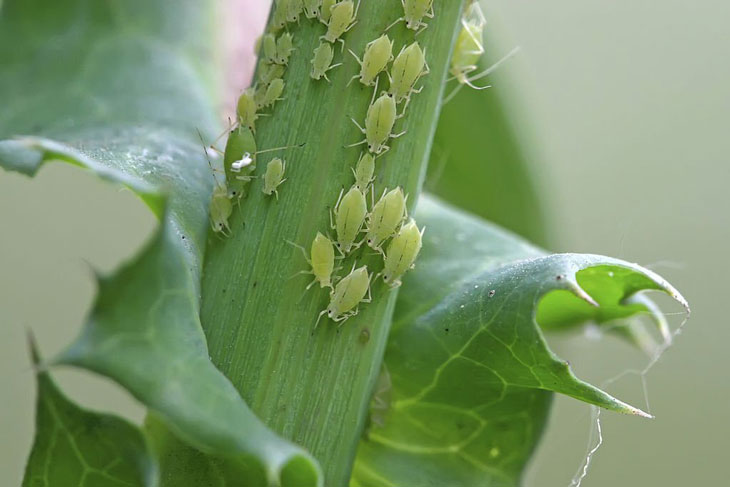
If you’ve ever noticed small bugs crawling on your kale, you may be wondering if it’s safe to eat. They’re most likely aphids!
Aphids are common pests on many types of produce, including kale. You can find these bugs on kale from stores and in the garden.
So, are aphids on kale safe to eat?

While it can be unsettling to find these insects crawling around your food, the consensus is that they’re not harmful to eat.
This article will explore the potential risks associated with consuming aphids on kale. For gardeners, we’ll also take a look at some possible solutions for eliminating them from your kale crops!
What Are Aphids?
Aphids are small, soft-bodied insects in the family of Aphididae, which eat plant sap.

They can be found in all kinds of leafy greens like kale, mustard, spinach, and more. Aphids use their special mouths, which can puncture through plants’ leaves, to suck the sap out of the plants.
After they’ve sucked out the sap and digested it, the aphids produce a sugary liquid known as “honeydew.”
This honeydew may then catch the eye of many insects, such as ants, who will feed on the sweet deposits.
Often this is the first indication that a tree or plant has been infested by aphids, as the honeydew deposits can lead to a fungus known as “sooty mold,” which turns green and healthy leaves and branches to a jet-black color.
A couple of aphids on most healthy, sturdy plants won’t harm them much. But plants that are heavily infested by colonies of hundreds of aphids can wilt and droop from excessive sap removal.
Aphids can also spread viruses from one plant to another. For all these reasons, aphids are considered a pest in agricultural settings.
Are Aphids On Kale Safe To Eat?
Yes, aphids are edible, but you should wash them off the kale before eating or cooking. According to the FDA, it’s safe to consume 50 to 60 aphids or even more for every 100 grams of veggies like broccoli or spinach.
And I see no reason you can’t do the same with kale! Eating aphid-infected kale can’t poison or cause diseases to you.
Generally speaking, it’s not harmful to accidentally eat aphids. If you’re wondering what happens if you eat aphids … since they’re soft-bodied insects, your digestive system can break them down without a problem.

However, kale aphids aren’t considered a kind of food, either. They’re so small that their nutritional content is more or less zero.
Plus, we doubt that there’s anybody who would purposefully eat aphids!
If you’ve been gardening for some time and you’ve eaten produce that you grew yourself before, there’s a good chance you’ve actually eaten an aphid or two.
But no need to worry! There’s never been a case of illness — however small — caused by ingestion of aphids.
Any disease or aphid-borne viruses that are carried by these insects are purely plant-based (meaning they’re only harmful to plants, not humans.)
So, can you eat lettuce with aphids or not? The answer is yes; it’s perfectly safe!

How to Wash Aphids Off Kale

Is it ok to eat kale with bug holes? I would say a big old yes if you know how to get rid of all the nasty aphids from your veggies. While not harming you, it’s not easy to munch on those disgusting insects, right?
Check The Kale Carefully Before Buying Or Harvesting
Whether you are enjoying store-bought or homegrown kale, it’s essential to inspect for aphids or other insects before harvesting or buying. As a seasoned gardener, I know how good these bugs are in the hide-and-seek game.
Look carefully throughout the plants, from their stems to leaves. If you spot any white flex, dark spot, or honeydew, there is a good chance that aphids are nesting there. Meanwhile, yellow spots on leaves indicate that the plants had undergone an aphid infestation before.
Once you notice these signs, turn the leaves upside down to see if any aphids are hiding there.
Rinse The Leaves Under Running Water
After confirming the appearance of aphids, it’s time to give your veggies a good wash. Rinse every leaf under running water to get rid of those insects. If they still stubbornly stick to the leaves, turn the water to a higher setting and rinse them again.
Many advise that you should wash kale under high-pressure water or use a water jet, but I don’t think that’s a wise move. Doing so can bruise the leaves or even tear them off, both of which can ruin your salad bowls!
Instead, I usually use my fingers to scrub the aphids off while rinsing kale under tap water. Also, never use soapy water unless you want to upset your stomach.
Wipe The Leaves Carefully
Your aphid-infected kale need this extra step to ensure they are completely free of those bugs. If the water can’t remove all of them, let a soft sponge or cloth take care of the rest for you. Gently wiping along the leaves can pry those stubborn aphids off.
Give Kale A Good Ice Bath
Now is the time to restore the kale’s crunchiness with an ice bath. At this step, you should successfully remove all the aphids, and even if there are some, the cold will kill them all.
As these insects can turn your veggies limp and mushy, the cold water can firm them up, making them fresher and greener. Soak your kale in ice water for about 20 minutes, and you are good to go.
Let Them Dry
In case any aphids manage to survive after the cleaning process, simply pat the veggies dry using a soft towel to remove them. This step also ensures that your kale will not turn mushy if left in water for too long.
Aphid Infestation of Kale
If you’re growing your kale at home and struggling with an aphid infestation, here is some useful information you need to know to combat it.
What Happens When Aphids Infest Kale Crops?
Aphid outbreaks on kale leaves can cause a variety of problems.
First, these tiny pests can feed on the thick, sappy juices from plants, depriving them of vital nutrients plants and causing wilting, yellowing, and deformed leaves.
Next, the aphids also secrete a sweet substance called honeydew, which can leave a waxy coating on the surface of your plants.
The honeydew itself isn’t harmful, but the sugar and nutrient-rich substance can encourage the growth of sooty mold on the kale.
Like honeydew, sooty cold doesn’t harm your plants, and you can wash them off. However, they ruin the look of your garden by making dark spots on your plants’ leaves.
The mold can block your plants’ access to light and nutrients if left uncontrolled.
Lastly, aphid populations can grow quickly if not controlled, leading to large-scale defoliation and stunted or reduced crop yields.

Is It Safe to Eat Aphid-Infested Kale?
As we mentioned earlier in the “Can you eat aphids” section, it’s completely safe to eat aphids. The idea of accidentally ingesting a couple of these bugs may sound gross, but they aren’t harmful.
How to Wash Aphids Off Kale
Aphids are one of the many reasons you should wash your kale carefully with soapy water before eating.
However, to ensure that nothing’s left on your kale, wipe with a sponge to take out any remaining aphid colonies after you’ve rinsed the produce. Pay close attention to the undersides of the leaves.
That’s where adult aphids like to hang around the most.
Can You Eat Kale That Has Been Eaten by Bugs?
A common question we’ve received is, “Is it ok to eat kale with bug holes?”
Any kind of leafy greens with holes in them are safe to eat. The damages are mostly aesthetic and won’t be harmful.
You can eat them whole or, if you’re a bit more worried, just clip away the damaged parts.
How to Keep Aphids from Infesting Kale Crops?
Here are a couple of tricks that you can use to protect your kale crop from being infected by aphids.
Monitor Your Crops Regularly
Inspect your crops weekly for signs of aphids, such as small yellow or white spots on the leaves. If you do spot aphids, treat the problem immediately by using insecticidal soaps.
Once you don’t want to use systemic insecticides, there are many homemade remedies that you can use, such as spraying the leaves with a strong stream of cold water to wash off the aphid eggs and any lingering aphids on plants.
Plant Repellent Flowers Nearby
Plant flowers such as marigolds and nasturtiums in the vicinity of your kale crop have a strong scent that repels aphids from infesting the area.
Use Companion Plants
There is a variety of plants that can be used to draw aphids away from your kale, such as dill, coriander, fennel, and caraway.
These companion plants are much more attractive to aphids, so the aphids will concentrate on these plants more than your precious kale crops.
You can also use other pest-attractors like nettle or mint to attract lady beetles, which are natural predators of aphids.
These handy little bugs in kale will keep the aphids away, acting as a kind of biological control to your aphid problem.
Introduce Beneficial Insects
Certain beneficial insects, such as lady beetles and lacewings, are natural aphid predators.
They can offer great protection against them if released into your garden in large enough numbers to keep their populations down.
Conclusion
Are aphids on kale safe to eat or not?
Yes! Whether it’s on kale or lettuce, these bugs are generally safe to eat. While, admittedly, many aphids carry pathogens like bacteria and aphid-borne viruses, these pathogens are all plant-based.
This means they’re harmful to plants but not to humans. So, don’t worry if you accidentally eat a couple.
For gardeners, many pest control methods can drastically reduce their growth if you’re concerned about aphids infesting your kale. We’ve given you a couple of tricks up above.
If you have any other questions, leave a comment below, and we’ll get back to you as soon as possible. Take care!
